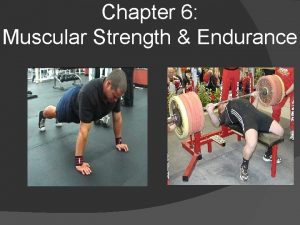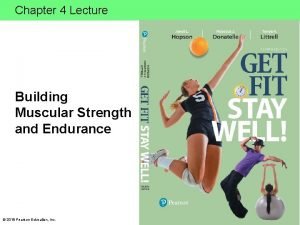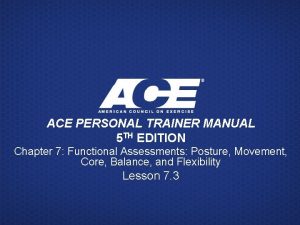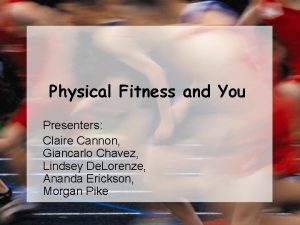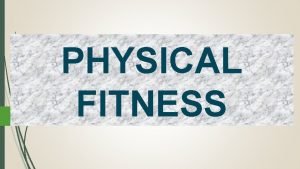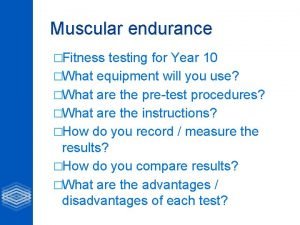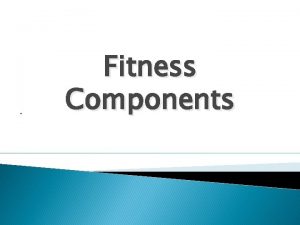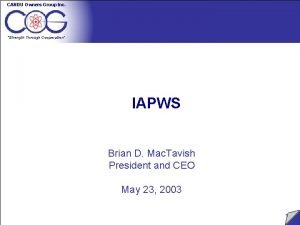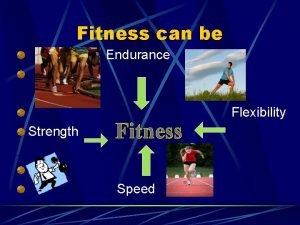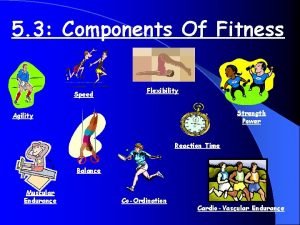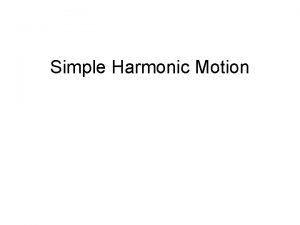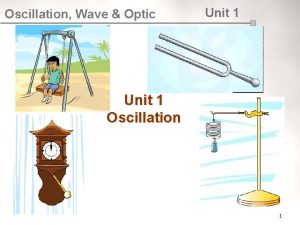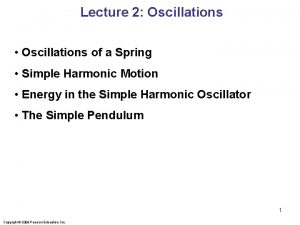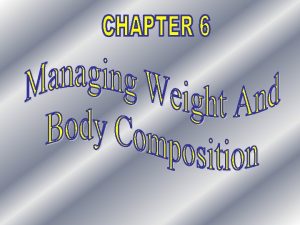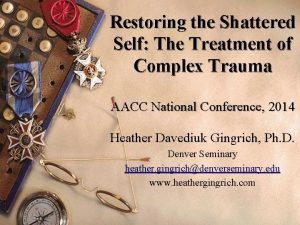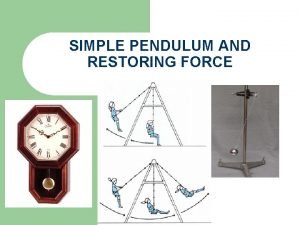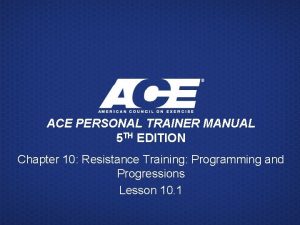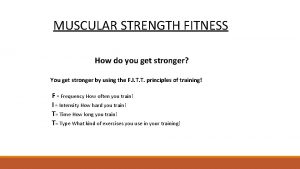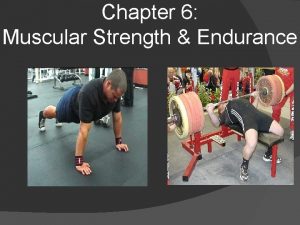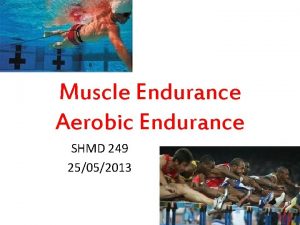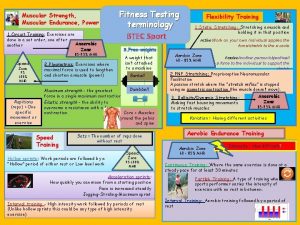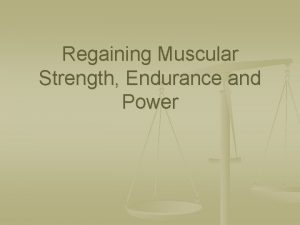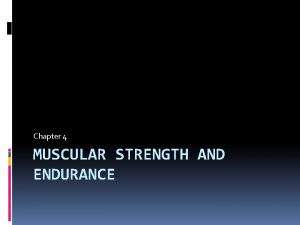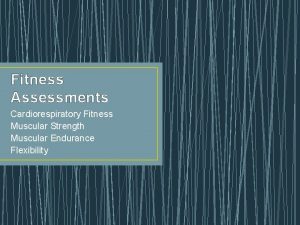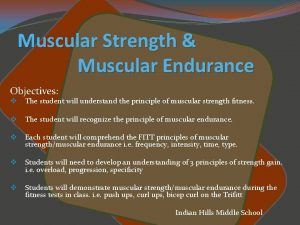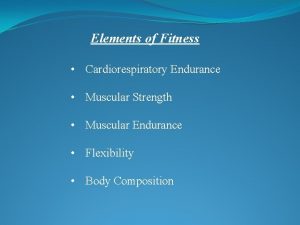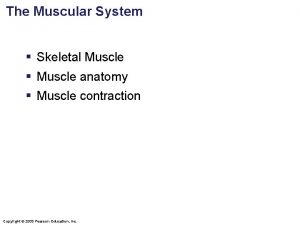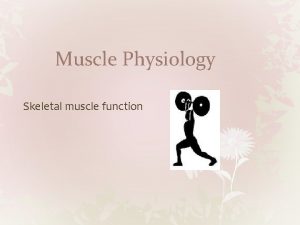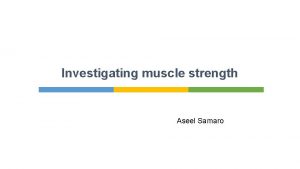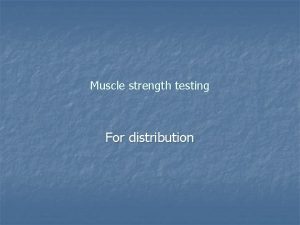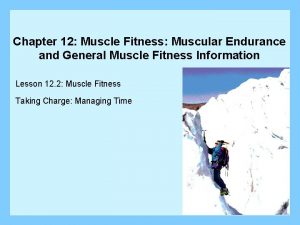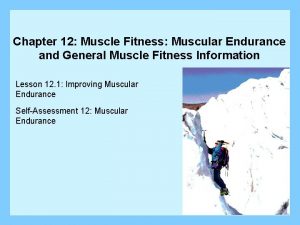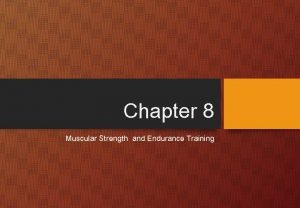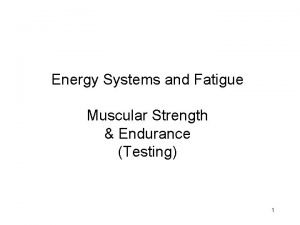Restoring Muscular Strength Endurance and Power Muscle Strength

























- Slides: 25

Restoring Muscular Strength, Endurance, and Power

Muscle Strength, Power, and Endurance Muscular strength: ability to generate force against resistance Muscular endurance: repetitive muscular contractions (increase strength = increase endurance Power: the relationship between strength and time

Muscle Contractions � Isometric contraction ◦ No length change occurs during contraction � Concentric- shortening of muscle with contraction in an effort to overcome more resistance � Eccentric - lengthening of muscle with contraction because load is greater than force being produced

Factors that Determine Levels of Muscular Strength � Size of muscle: ◦ Function of diameter and of muscle fibers ◦ Hypertrophy vs. Atrophy � Number of muscle fibers � Neuromuscular efficiency ◦ Initial gains are due to increased efficiency �More effectively engage specific motor units � Biomechanical factors ◦ Bones and muscles = Levers and pulleys

� Fast-Twitch vs. Slow-Twitch Muscle Fibers � Motor units with distinct metabolic and contractile capability Individual make-up ◦ Muscles contain both types of fibers ◦ Muscle functioning impacts ratios (postural vs. powerful movement) ◦ Genetically determined � Slow twitch (Type I): ◦ Generally major constituent of postural muscles � Fast twitch (Type II) ◦ High force in short amount of time ◦ Produce powerful movements

� Levels of Physical Activity ◦ Will influence increase/decrease in muscle strength ◦ Also impacts cardiorespiratory fitness, flexibility and increases in body fat � Overtraining ◦ Psychological and physiological breakdown ◦ Signs �Apathy, loss of appetite, staleness, declines in performance, weight loss, inability to sleep ◦ Prevent through appropriate training protocol, proper diet, and rest

Resistance Training � Among the most essential factors necessary when restoring function of a body part to pre -injury status � Variety of techniques can be utilized ◦ ◦ ◦ Isometrics Progressive resistance-Isotonic Isokinetics Plyometrics Circuit Training Calisthenic � Emphasize work through a full ROM

Techniques of Resistance Training � SAID Principle (Overload/Progression) must be applied � Specific Adaptation to Imposed Demands � Must work muscle at increasingly higher intensities to enhance strength over time � If intensity of training does not increase, but training continues, muscle strength will be sustained

Isometrics ◦ Performed in early part of rehab following period of immobilization ◦ Used when resistance through full range could make injury worse ◦ Increase static strength, work to decrease/limit atrophy, create a muscle pump to decrease swelling

Isometric Exercise � Contraction where muscle length remains unchanged � Muscle contraction that lasts 10 seconds and should be perform 5 -10 times/daily � Pro: quick, effective, cheap, good for rehab � Con: only works at one point in ROM, produces spiking of blood pressure due to Valsalva maneuver

Progressive Resistance Exercise(PRE) or Isotonic Exercise ◦ Can be performed using a variety of equipment ◦ Utilizes isotonic contractions to generate force while muscle changes length ◦ Concentric and eccentric strengthening exercises should be utilized

Progressive Resistance Exercises (Isotonic training) � Shortening/lengthening contractions against fixed resistance � Concentric vs. Eccentric � Various types of equipment can be utilized ◦ (Free weights, machine weight) � Spotter is necessary for free weight training to prevent injury, motivate partner, and instruct on technique

� Concentric and eccentric training should be incorporated for greatest strength improvement � Concentric phase of lift should last 1 -2 seconds; eccentric phase 2 -4 seconds � Variations exist between free and machine weight lifting ◦ Motion restrictions, levels of muscular control required, amount of weight that can be lifted ◦ Equipment design, varying resistances

� When training should be able to perform 3 sets of 6 -8 repetitions � Increases should occur in increments of 10% � Training of a particular muscle group should occur 3 -4 times per week (not on successive days)

Progressive Resistance Exercises

Muscular Endurance vs. Strength � Training for endurance enhances strength and vice versa � Training for strength should involve lower repetitions at heavier weight � Training for endurance requires lower weight at 12 -15 repetitions

Open vs. Closed Kinetic Chain Exercises � Anatomical functional relationship for upper and lower extremities � OKC (Open Kinetic Chain) ◦ When foot or hand are not in contact with the ground or supporting surface � CKC (Closed Kinetic Chain) ◦ Foot or hand are weight bearing ◦ Widely used = more functional

Isokinetic Exercise ◦ Incorporated in later stage of rehabilitation process ◦ Uses fixed speeds w/ accommodating resistance to provide maximal resistance throughout ROM ◦ Speed of movement can be altered ◦ Commonly used as part of the criteria for return to functional activity

Isokinetic Training � Muscle contraction at a constant velocity � Maximal and constant resistance throughout the full range of motion � Maximal effort = Maximal strength gains � Rehab � Never widely used in strength training � Losing popularity in rehabilitation settings


Plyometric Exercise ◦ Incorporated into later stages of program ◦ Use quick stretch of muscle to facilitate subsequent concentric contraction ◦ Useful in production of dynamic movements �Associated with muscular power �Generation of force rapidly – key to successful performance in many activities

Plyometric Exercise � Rapid stretch, eccentric contraction followed by a rapid concentric contraction to create a forceful explosive movement � Rate of stretch vs. magnitude � Jumps, bounds, medicine ball throws � Very technical training - skills must be learned with appropriate technique � Often develop muscle soreness as a result of extensive eccentric loading

Plyometrics- jumps, hops, skips

Calisthenic Strengthening Exercises � Free exercise � Isotonic training � Gravity’s involvement determines level of intensity � Full range of motion, may incorporate holding phase � Pull-ups, push-ups, back extensions, leg extensions

Circuit Training � Combination of exercise stations � 8 - 12 stations, 3 times through � Design for different training goals ◦ Flexibility ◦ Calisthenics ◦ Aerobic exercise
 Differentiate muscular strength from muscular endurance
Differentiate muscular strength from muscular endurance 2+ muscle strength
2+ muscle strength Venn diagram of muscular strength and endurance
Venn diagram of muscular strength and endurance Rombert test
Rombert test Claire cannon
Claire cannon The ability to do strength work at an explosive pace.
The ability to do strength work at an explosive pace. Muscular strength fitness test
Muscular strength fitness test Local muscular endurance definition
Local muscular endurance definition Brian mac muscular endurance
Brian mac muscular endurance Be endurance
Be endurance Difference between strength and endurance
Difference between strength and endurance Strength endurance speed flexibility
Strength endurance speed flexibility Restoration of the tabernacle of david
Restoration of the tabernacle of david Si unit of spring constant k
Si unit of spring constant k Ap physics 1 shm review
Ap physics 1 shm review Units for period of a pendulum
Units for period of a pendulum Restoring force of a pendulum
Restoring force of a pendulum Restoring lost body fluids
Restoring lost body fluids Dissociative disorder not otherwise specified
Dissociative disorder not otherwise specified Spiritual landmarks
Spiritual landmarks Define periodic motion
Define periodic motion Muscular strength
Muscular strength Muscular strength
Muscular strength How is muscular strength defined?
How is muscular strength defined? Power traiangle
Power traiangle Refractory period cardiac
Refractory period cardiac

